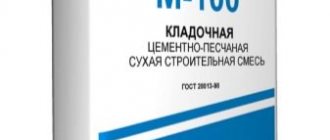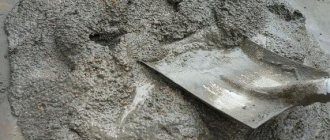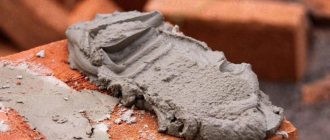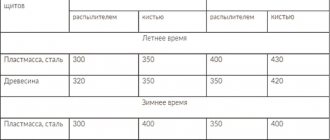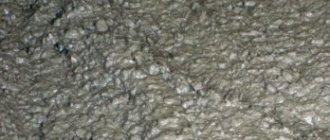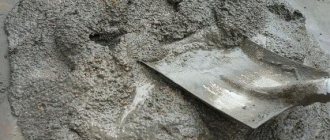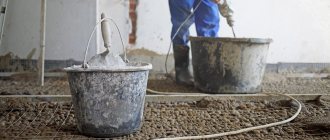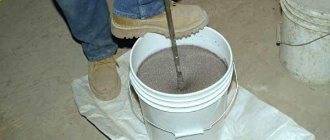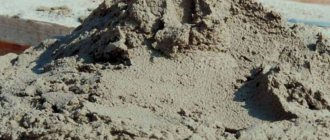In the construction industry, dry mixes are considered popular at all innovative stages. They are most often used in procedures associated with repair (restoration) work. The key element of the binder is the sand-cement mixture
.
General technical specifications for PTS M 150 screed consumption
Multifunctional central station M 150
How to calculate the consumption of m150 mixture per 1 m2 of floor screed made from cement-sand mortar
The consumption of M150 mixture per 1 m2 of screed is the main parameter that determines the cost of pouring the floor, duration and resource costs.
It is very important to be able to correctly calculate the consumption of a cement mixture, because an insufficient volume of solution will lead to technological downtime and deterioration in the quality of the pouring layer due to interruption; exceeding the required volume will lead to unjustified costs (after all, the prepared mixture must be used within 2 hours, then it will be unusable) . Despite the huge variety of flooring materials on the market, the M150 mixture is considered the most optimal choice due to its reasonable cost, versatility, good technical characteristics, and ease of installation. It is also important that the mixture dries quickly enough and can be used not only for pouring screed, but also for plastering, laying walls made of brick and other blocks, as well as for other work.
LLC Svoy Master & PoliStyle
Articles:
Construction mixture based on cement-sand
The list of the most common materials on construction sites includes cement mixtures. The basis for them is cement and sand, but to improve the properties, various additives (plasticizers) are introduced into the composition. DSPs are used at almost all stages - from installing the foundation to plastering the walls. The dry mixture only needs to be diluted with water in the proportions indicated on the container and left for several minutes until it reaches the correct state. It is its ease of use that has made it so popular.
Cement-sand mixture is the basic building material for pouring foundations and laying walls; leveling floors, plastering surfaces and sealing joints.
The brand is determined based on the specific type of work:
- M100 – plaster;
- M150 – universal (concreting, installation, masonry);
- M200 – assembly and masonry;
- M300 – foundation, filling;
- M400 – especially strong foundation and casting material.
Plasticizers expand the range of applications. Thanks to additives, adhesion (the degree of adhesion of dissimilar surfaces), water-repellent properties, and mechanical stability of the finished DSP change. Their presence also affects the price of the material towards its increase.
GOST standards and marking of TsPS
The technical parameters of dry cement-sand mixtures are regulated by the provisions of GOST 28013 (1999). The classification is carried out according to:
- density (light, heavy);
- the number of binders (simple - one, complex - several);
- purpose (plastering, masonry, pouring).
For solutions based on a mixture, GOST regulates:
- humidity;
- density;
- temperature range;
- plastic;
- delamination.
The hardened mass is assessed by:
The M200 marking indicates that 1 cm³ of the hardened mixture can withstand a static load of 200 kg.
The container in which the CPS is packaged must provide the consumer with complete information about the composition, method of use and shelf life. The manufacturer is required to indicate the technical characteristics of the cement-sand mixture:
- material class;
- concrete grade by compressive strength (MPa);
- additives used (type, quantity);
- maximum aggregate fraction (mm);
- volume of water to obtain the finished mass (l).
In addition, the container displays the manufacturer’s trademark, weight, release date, and expiration date.
Application of DSP
This is a cement-sand plaster mixture. The composition includes cement, river sand and lime. For 10 kg of dry matter, add 2 liters of water. The price is low because little cement is used.
Available in several modifications. Accordingly, it is suitable for plastering, filling joints, installation and masonry work inside and outside buildings.
Mounting and masonry M200 is the best option for walls. In its universal composition it is also suitable for strip foundations. The third option for the cement-sand mixture is plaster.
4. M300.
Cement-sand mixture M300 (sand concrete) is intended for concreting work that requires high strength of the finished layer. It is used as the main material for pouring a foundation or concrete screed, and arranging floors in places with high traffic. It consists of cement and sand of various fractions, and is used both inside and outside buildings. The cost of a bag of sand-cement mixture M300 weighing 50 kg is about 140 rubles.
This is the most durable, frost-resistant and plastic sand concrete for foundations, floors, load-bearing structures, outdoor areas, and reinforced concrete products. Cement predominates and many plasticizers are added, which makes the cost of M400 high.
Average consumption
Any amount of money stated for a bag is meaningless unless the volume of consumption is indicated. But it can differ significantly for the same area, it all depends on the thickness of the layer. Consumption per 1 m² of dry cement-sand mixture is in the range of 1.7-1.9 kg. But manufacturers indicate it per 1 mm of thickness.
It will take about 3.6 kg to process a square meter of surface with a 2-mm layer, and about 9 kg with a 5-mm layer. As practice shows, when pouring floors with a layer of 10 mm, 21-22 kg of cement-sand mixture are consumed per 1 m². Based on this situation, more than 400 kg of M300 sand concrete will be needed for 20 m². Therefore, in order to save money, many individual developers do not use the factory composition, but prepare it themselves.
For dry mixture
When using dry and semi-dry mixtures to organize screed, it is necessary to take into account the characteristics for each specific mixture, which can be found on the packaging. Usually indicate the volume of the mixture to cover one square meter of the base with a layer of 1 mm. For example, to obtain a solution of grade M100 sufficient for use indoors in residential premises, the manufacturer of semi-dry floor screed recommends the following consumption:
- mixture consumption is 2 kg per square meter with a screed thickness of 1 mm;
- water consumption is 0.22 l per 1 kg of mixture.
Taking into account the above data, you can calculate the required material for 30 square meters with a screed thickness of 40 mm.
It is necessary to multiply the area by the consumption of the mixture by 1 m2 and by 4 (since the planned thickness of the screed is 4 mm, and the calculation is given for a thickness of 1 mm). We get: 30x2x4 = 120 kg, while the volume of water required: 120 kg x 0.22 l = 26.4 liters.
(function(w, d, n, s, t) w[n] = w[n] || []; w[n].push(function() Ya.Context.AdvManager.render( blockId: "RA- 510923-1", renderTo: "yandex_rtb_R-A-510923-1", async: true >); >); t = d.getElementsByTagName("script")[0]; s = d.createElement("script") ; s.type = "text/javascript"; s.src = "//an.yandex.ru/system/context.js"; s.async = true; t.parentNode.insertBefore(s, t); >) (this, this.document, "yandexContextAsyncCallbacks");
Specifications
Almost all manufacturers produce cement-sand products consisting of the following components:
- Portland cement (grades PTs400/500 are used);
- a scattering of purified fractional sand (0.1-1 mm);
- mineral powder component (0.1-0.5 mm);
- a number of modifying additives and plasticizing organic elements.
Manufacturing is carried out in accordance with GOST 3051597, and the addition of the sand component is carried out in accordance with TU 5711-002-05071329-2003. Other parameters are shown in the summary table.
| Density | 900 kg/m3 |
| Consumption | 16-17 kg/m2 at a height of 1 cm |
| Color | grey |
| Shelf life | maximum 2 hours |
| Adhesion | 0.6 MPa |
| Compressive strength level | 15 |
A distinctive feature of the mixture from M300/400 is the variability of its operation. Only the liquid content changes when diluted.
The cooking process is quite simple. The powder is poured into liquid (1.8-2 liters per 10 kg of composition). After mixing, the consistency should be uniform. Given the low viability, the mixture must be consumed in one go and as quickly as possible (within 120 minutes).
Cement consumption rate per cubic meter of solution
| Brand of solution | Recommended brand of binder | Cement consumption per “cubic meter” of solution, kg |
| M200 | M500 | 415 |
| M400 | 480 | |
| M150 | M500 | 345 |
| M400 | 400 | |
| M300 | 490 | |
| M100 | M500 | 275 |
| M400 | 325 | |
| M300 | 395 | |
| M75 | M500 | 220 |
| M400 | 265 | |
| M300 | 335 | |
| M200 | 445 | |
| M50 | M400 | 200 |
| M300 | 250 | |
| M200 | 345 | |
| M25 | M300 | 155 |
| M200 | 215 |
Scope of application of different brands of solution
The rate of cement consumption per 1 m3 of solution will be incomplete if you do not inform readers for what purposes a solution of a particular brand can be used:
- Brand M25. Mixed (complex) mortar for masonry building structures;
- Brand M50. A popular mixed complex mortar for laying bricks (other types of “stone materials”) and arranging reinforced (“mesh”) floor screed;
- Brand M75. It is used for: stone and brick masonry, production of vibro-brick structures, installation of floor screeds of small thickness, installation of lintels (no more than 2 meters long), arrangement of underground communications, construction of structural elements of heavily loaded premises of production workshops;
- Brand M100. Application – construction, masonry and plastering work of all types, as well as filling horizontal and vertical joints of panel structures;
- Brand M150. It is used for masonry and plastering work, finishing hydraulic structures, laying ceramic tiles, arranging a finishing screed, and also for filling the seams of panel walls. In addition, M150 mortar can be used to fill the foundations of buildings located on “weak” and wet soils;
- Brand M200. It is used for installation of vibrating brick panels, filling joints, plastering work, waterproofing and laying finishing materials.
Amount of solution consumption per square meter
Today in construction stores the range of building mixtures is huge, thanks to this you can choose your composition for specific work. When choosing a building material, it is important to know its consumption. In this case, you can purchase the exact amount of the mixture and save on buying unnecessary material. But each type of work has its own expense. DSP is quite convenient and popular material.
For floor screed
How to calculate the consumption of CSP per 1 m2 of screed? The process of calculating the mixture for floor screed is simple, so all these manipulations can be performed in your head. No complex mathematical formulas are used here. Let's look at the whole process using a specific example. For a screed of 10 cm per 1 m2 you will need 50 kg of M400 mixture.
If you need to get highly accurate results, then you need to apply the following formula: multiply the area by the height of the screed. As a result, you should get a number that will indicate the required amount of solution.
For example, the area under the screed is 50 m2, and its height is 8 cm. The above formula takes the following form: 50 m2 × 0.08 m = 4 m3. But grains of cement and sand play a very important role here. When preparing a solution, they reduce their volume under the influence of liquid. Consequently, the total volume of the prepared solution will be less than the amount of materials spent on it. When choosing a material, it is important to consider not only the brand, but also the GOST of the cement for the job.
Consumption per 1 liter is approximately 1.4 kg of dry mixture. To put it another way, from 50 kg of composition you can get 36 liters of solution. As a result, the resulting volume of the mixture will be equal to 2/3 of the volume of materials involved.
This indicator can be calculated only with accurate knowledge of the quality characteristics of the sand used. Often this information is not included on the packaging. For this reason, it is best to calculate the necessary data without taking into account shrinkage, and then add the approximate amount of materials used to eliminate it.
The video shows a recipe for a floor screed solution with a consumption of cement-sand mixture per 1 m2:
Plastering the surface
If you decide to level your walls or simply remove defects such as depressions and cracks, then using sand-cement plaster would be an excellent option. Its consumption will vary with different laying thicknesses. If the layer thickness is 5 mm, then the consumption will be 7 kg per m2.
Find out which foundation to choose for a house made of aerated concrete.
Reviews on which adhesive to use for aerated concrete: .
Here you can watch a video about the disadvantages of a house built on screw piles.
In terms of volume, the amount of solution per 1 m2 with a thickness of 5 mm will be 5-6 liters. The layer thickness can reach from 5 mm to 30 mm. Most often in practice, a bag of cement is used, slaked lime - 40 kg, sand - 550 kg, water - 100 liters. If the process of preparing the plaster was carried out correctly, then it is possible to achieve high-quality wall cladding. In addition, it is quite possible to reduce the consumption of cement for repairs and cladding of the house several times.
Useful tips
Some tips from experts will help you increase the efficiency of working with the material:
- If the filling is of poor quality, voids will appear inside the composition, which can only be removed with special equipment.
- For small structures, grade 100 products are suitable.
- When creating a strip foundation, it is recommended to use grade 200 composition.
- It is impossible to erect a strip foundation during periods of cold weather. If the liquid freezes inside the concrete, the volume will increase and the structure will collapse.
- When pouring the foundation in the summer, within a few days after installation, it should be sprayed with water. As a result, the structure will not crack and will adhere evenly over the entire surface.
Features of the construction of a strip foundation
To ensure uniform drying of the concrete structure, it should be covered with film. This will prevent the outer layer from drying out quickly, and the composition will harden more evenly. Drying time depends on the thickness of the concrete layer.
The correct proportions allow you to create a high-quality mixture
Using a table of proportions for using concrete, you can create a high-quality and homogeneous solution. This will guarantee the durability and strength of concrete structures. Compliance with technical standards in the manufacture of building mixtures is important.
Expense and acquisition
Uninformed consumers are usually interested in how much material they need to purchase for the job if they use the M-150 dry mix. Consumption depends on the type of work performed. For example, for one sq. m area will need about 20 kg of ready-made solution if it is applied in a layer 1 cm thick.
If it is brickwork, then the results are completely different, since they depend on the thickness of the masonry material. The quantity is indicated per 1 sq. m:
- Half a brick – 25 kg.
- One brick – 50 kg.
- One and a half bricks – 75 kg
- Two bricks – 100 kg.
There are plastering, installation and masonry and dry mix “M-150 universal” on sale. A package of any type of substance weighs 50 kg: it is convenient for transportation, storage and use, but some manufacturers also produce 25 kg bags. Which option to choose depends only on the amount of work to be done and on the manufacturer’s rating. If the latter does not inspire confidence, it is better not to save money and turn to trusted brands.
Specific gravity of liquid concrete
| Brand | Mass of a cube of liquid concrete, t |
| M100 | 2,366 |
| M150 | 2,36 |
| M200 | 2,362 |
| M300 | 2,358 |
| M400 | 2,35 |
| M500 | 2,355 |
The ratio of mass to occupied volume (specific gravity) depends on the proportions of the components, the volume of liquid, the mixing method, etc. The volumetric mass of liquid concrete and methods for its calculation are prescribed in GOST 12730.1-78.
What to consider when calculating?
Before starting calculations, you need to determine:
Purpose of the building mixture. To perform installation, construction and finishing work, different types of concrete are used. By purpose they are classified into:
- commodity - for pouring columns, foundations, reinforced concrete structures;
- hydraulic engineering – lining of sluices, canals, water supply and sewerage systems;
- airfield for various road surfaces;
- special purpose – protection from radiation, acid, high temperatures.
Specific and volumetric weight of concrete in 1m3, table of weights of all brands.
Concrete is the main component of any construction work, be it ordinary repairs or the construction of pits and structures. It has high strength initially, but with the use of additives it can improve its characteristics.
During construction, first of all, how much concrete weighs is calculated, since based on this characteristic it is determined by the specifics of its use and application. The weight of the solution depends directly on the components added as filling. These can be materials such as crushed stone, expanded clay, pebbles and many others.
Also, when kneading, the volume of water spent is taken into account. Based on these characteristics, concrete is divided into four types: light and heavy, especially light and especially heavy.
Weight of 1 cube of concrete of all brands and classes, table: Detailed weight table.
| Concrete grade | Concrete class | Weight of 1 m3 of concrete (kg) |
| M100 | B7.5 | 2494 |
| M200 | B15 | 2432 |
| M250 | IN 20 | 2348 |
| M300 | B22.5 | 2502 |
| M350 | B25 | 2502 |
| M400 | B30 | 2376 |
Types of specific gravity of 1 cube of concrete.
The most common way to classify the mass of a cube of composition is by dividing it according to specific gravity.
According to the volumetric mass, the following types of concrete are distinguished:
- Particularly light: Weight 500 kg maximum per cubic meter. Characterized by the content of air cells with a diameter of 1-1.5 mm and a porous base. These are the familiar foam and gas blocks, which are based not only on classic cement and sand, but also on a foaming agent that creates cells with air. This allows for low weight and good thermal insulation properties.
- Lightweight - concrete compositions filled with lightweight porous aggregates, such as expanded clay or without aggregates, but having a porous structure, such as foam concrete or aerated concrete. A cube (cubic meter) of lightweight concrete weighs from 500 to 1800 kg. A cubic meter of concrete includes about 600 kg of sand - the main and essential component. Lightweight concrete is usually used in the form of ready-made building blocks.
- Heavy. This is the most common (classic) type of mortar. It is best suited for the construction of the main elements of load-bearing structures, pouring screeds, erecting fences, etc. The composition of heavy concrete includes large-sized and massive fillers: coarse sand, gravel, crushed stone. They occupy the bulk of the mixture. A cubic meter of such material weighs 1800-2500 kg.
- Particularly heavy . Metal fillers are used in production, giving the finished product a massive appearance. The weight of a cube of concrete is 2500-3000 kg. Super-heavy mixtures necessarily contain high-strength cement. They are not used in private housing construction. They are usually used to make protective structures for special purposes, for example, for nuclear reactors.
Specifics of mixtures, characteristics, selection recommendations
The main elements are cement and sand. The quantity that appears after the letter “M” indicates the load (kilogram per sq. cm) that the hardened solution will withstand. Take into account that the indicator is approximate, since a large number depends on various factors: the correct preparation of a multifunctional solution, the implementation of work technologies, etc. For example, the load for the M150 brand is approximately 150 kilograms per 1 cm2.
DSPs have the following characteristics:
- Drying time.
- Composition, proportions. For example, M150, 100 does not contain organic impurities.
- The ability to contain water (according to GOST, this figure is 90%).
- Frost resistance, which is established in cycles.
- Delamination index.
- Consumption of cement and sand mortar per 1 m2.
- Thickness.
If mixtures with identical properties are sold, then first you need to check the ratio of height, flow rate (kg/m2). Practice demonstrates: buying a DSP at a lower price will ultimately turn out to be more expensive than a composition with a higher cost.
When purchasing, you must take into account that the manufacturer’s specified usage rate per sq. m. meter is aimed at highly qualified specialists. This point must be taken into account when purchasing the solution. Practical consumption will be 12% higher.
